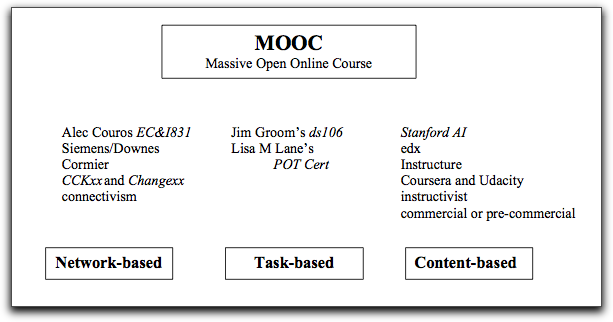So I return from Connected Courses (whole other wonderful story) to find Alan Levine’s call for Open Educational Resources, and I think, hey, no problem, got lots of ’em…
I started hunting them down. Alan’s right – it wasn’t easy. Found some scat. Some prints… Oh! I remembered where I put one!
In the MERLOT cage…

where it’s so lonely, since 2006. No peer reviews, no discussion, no indications of use. Did anyone use it? I don’t know. It says it’s copyrighted when I didn’t copyright it. I’ll have to stuff it and mount it on the wall. Can’t claim it as a live sighting.
Over the years, I’ve seen my stuff, the stuff I put out in the wild. I’ve seen this image from my blog in a number of places (like wikis and Stephen Downes’ OL Daily). The post that went with it has been cited in a number of dissertations about MOOCs.

Are those real sightings? or just scat?
Maybe it’s more important that others have sighted my stuff, and used it for themselves, rather than redistributed it. They’ve taken a photo of my OER in the wild and put it on their wall of learning instead of cloning it. Before Slideshare got rid of my audio (for which I shall never forgive them), I had a number of lectures there as slidecasts.
Over 6,000 people viewed my “A Very Brief History of American Women Before 1919” (now in YouTube). Over 5,000 viewed my 6-slide presentation on Online Learning Theory. But what’s really interests me are my hour-long class lectures in history, which (when they had audio) were like taking a whole correspondence class in Western Civ. Thousands of views, many from regions far from the US. Somebody out there was learning, though without the audio they’re now learning a lot less.
So in Slideshare I have a graveyard of OERs, each with a flashy tombstone and visitors who put flowers on the graves.
I also have a fairly complete bank of my online lectures. They’re on a web page, in plain ole HTML. Does anyone use them? I don’t know.
I use several tools designed to track my influence on the web, but they hardly ever tell me when people post about me, so I can’t find these OERs either. (Lisa M Lane is the name I use. The other two Lisa M Lanes who are big on the web are an author of erotic vampire novels and a chess champion. I gave up.)
Do articles count as OERs? I put them on the open web so anyone can use them. Tweets? Flickr pics? Blog posts? This blog post? What about my the assignments I added to ds106?
So, like any academic, I’m gonna question the proposition. What is an OER? Is it a learning object in a repository? An idea (written or visual) that I put on the web and others used? Or are all these just blurry pictures?
Lisa, I saw this post yesterday and kept on thinking about it, since this is a topic much on my mind this summer. Although I don’t think I really answer your questions, I wrote up a blog post here on why I value open content:
http://oudigitools.blogspot.com/2014/07/thoughts-on-value-of-open-content.html
And I guess I really don’t even use the phrase OER a lot because, at least for me, it’s not even exactly helpful (which is why I am a “secondary” type of person per Martin Weller’s categories). The crucial term for me is OPEN (i.e. really open, on the open Internet, searchable, linkable – no login, no password), and another key term for me is PUBLIC DOMAIN (since I am lucky enough to be able to rely almost entirely on the public domain for the content I am repurposing). Is the public domain an OER? Is it millions and millions of OERs? I’m not sure, but the public domain is essential to the content creation/curation work that I do, and I make sure to publish every single thing I create online. It’s easy, it’s optimistic, it works for me! So I use the words “open” and “public domain” a lot, but I really don’t use the term OER much at all.
Meanwhile, I am jealous of your doppelgangers. There are lots of Laura Gibbses out there, but mostly lawyers and doctors, although there is one TV reporter and also an artist. But nothing so exciting as the author of an erotic vampire novel! 🙂
So maybe everything we create out there is an OER?
Thanks Lisa, your effort at sharing are vast and certainly “count” for sharing. It’s actually hard to find examples of ways people have reused your content unless they actually did that courteous act of letting you know via email, tweet, letter in the mail, etc.
I remain completely gobsmacked, for all the stuff people tweet, talk about all these great resources, why can’t a few people just tell me a story of one small bit of re-use. Maybe I am not asking the right way…
Is “story” throwing them off? That implies a beginning (I post an OER), a middle (someone uses it) and an end (I find out or are told and that’s interesting somehow).